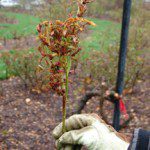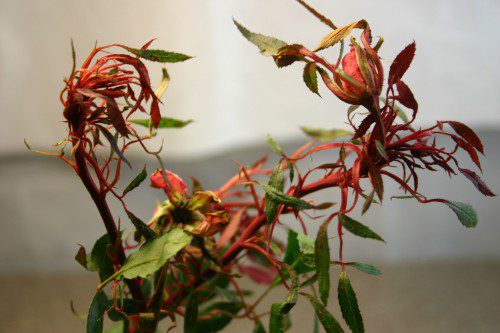RRD-A Brief Insight To Whats Happening In The World Of Knock Out Roses
Many of us have been astounded by the beauty and ease of the Knock Out Rose, but there is something amiss going on in the garden lately…and we’ve been getting an influx of calls and stop ins asking “Whats going on with my Rose, and why the heck is it growing at an ultra mega fast pace out of one node? You promised me Knock Out Roses were care free and low maintenance”. Our answer is always the same, a sullen look and the response “I’m sorry sir/ma’am, you’re rose has Rose Rosette Disease” (Insert dun dun dun here)
Rose Rosette Disease = a virus transmitted by the eriophyid Rose Leaf Curl Mite Phyllocoptes fructiplilus, which inhabits the shoot tips and leaf petal bases of roses, as well as by grafting but not by seed or many other common vectors.
 This does NOT mean you shouldn’t plant roses at all though. With a little planning and good horticultural practice, you may not even see this at all. This article is geared more towards those who already HAVE this problem–its in no way intended to steer people away from the Knock Out Roses. They are magnificent additions to any garden and really are the most effortless Rose Bush available.
This does NOT mean you shouldn’t plant roses at all though. With a little planning and good horticultural practice, you may not even see this at all. This article is geared more towards those who already HAVE this problem–its in no way intended to steer people away from the Knock Out Roses. They are magnificent additions to any garden and really are the most effortless Rose Bush available.
Although there aren’t statistics out yet on the percentage of Knock Out Roses that will actually become infected, we can tell you, from a nursery stand point–we carry thousands of Roses, Knock Outs and otherwise, and we haven’t seen a single case on our grounds. We’re going the extra mile to assure you that we’re checking to make sure that EVERY SINGLE ROSE that comes in and goes out of here is free of RRD.
Well, they are care free and easy to grow, and they are still beautiful, but a little microscopic mite is bringing a change of winds to the virtually perfect Knock Out Rose.
Although it almost looks like the plant is almost TOO healthy for its own good, this rapid growth out of one point is NOT normal and action should be taken immediately to destroy the plant material. The earliest symptoms of rose rosette disease include a red pigmentation of the underside of leaf veins followed by sharply increased growth of vegetative shoots, which are typically more succulent than normal and colored in various shades of red.
Leaves will become deformed, crinkled, and brittle with yellow mosaics and red pigmentation. As the disease progresses, leaves become very small, petioles are shortened, and most lateral buds grow, producing short, intensely red shoots. The disease causes the plant to be exceptionally susceptible to freeze damage. Symptoms on cultivated roses are typically less severe than on multiflora rose. Cultivated roses show symptoms of thickened, succulent stems and a proliferation of thorns.
 If you’ve found that you are infected with RRD, like stated before, you must destroy your plant! Sad but true, sorry! Please, don’t panic whenever you see red new growth though, that is normal, when it starts to Witches Broom, that’s a different story.
If you’ve found that you are infected with RRD, like stated before, you must destroy your plant! Sad but true, sorry! Please, don’t panic whenever you see red new growth though, that is normal, when it starts to Witches Broom, that’s a different story.
Witches Broom = is a disease or deformity in a woody plant, typically a tree, where the natural structure of the plant is changed. A dense mass of shoots grows from a single point, with the resulting structure resembling a broom or a bird’s nest.
Instead of just falling prey to something that you may not ever see until its too late, Integrated Pest Management can work in your favor by doing a few things to lessen your chance of becoming a target for the destructive little mites!
Right now is prime time for the mites to spread, predominately through the air and on passing winds. Since they are wingless, the chances of them spreading very far is pretty low, so if you do find that you are a victim and have Roses in other parts of your yard, it may not be a total lost cause. Treat the plant as you would any other plant infested with insects using an insecticide that has mites listed as a controlled pest. Also, you can nip it in the bud (no pun intended) by treating all of your roses something like Bayers Rose Three In One Treatment. This will almost act as a vaccine for your plant.
No promises are made that this will be all you need, and of course studies have show that Roses can last up to three years after becoming infected with this virus–but still–even though your plant is alive, it is much better for you to destroy it before it becomes the Typhoid Mary of your garden.
Knock Outs aren’t the only Roses that may fall victim to RRD (that’s of course why its not called KnockOut Rosette Disease). Early detection is the key to effective cultural control. If the disease is recognized early and the rose is removed, it is possible to save other roses in the garden and hopefully curb the spread of RRD.







